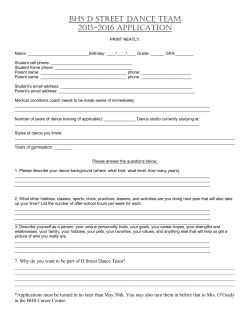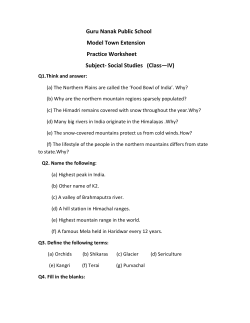
here - School of Engineering and Computer Science
Assignment 3 SWEN432-15/ass3(pm) School of Engineering and Computer Science SWEN 432 Advanced Database Design and Implementation Assignment 3 Due date: Monday 11 May at 23:59 The objective of this assignment is to test your understanding of: Document Type Definition, (DTD), XML Documents, XML Schema, and Identity constraints of XML Schema. The Assignment is worth 4.0% of your final grade. The Assignment is marked out of 100. Submit your answers to assignment questions via the school electronic submission system and a printed version in the hand-in box in the second floor of the Cotton Building. When doing the assignment you will need to use the xmllint XML parser to check whether your XML documents are valid with regard to a DTD or an XML Schema schema. You can use xmllint from UNIX shell. To do so, type >xmllint To get information how to use xmllint, type >man xmllint Include your commands and xmllint messages from the shell prompt in your answers. The xmllint parser does not recognize the syntax of new elements (like xsd:assert) introduced in XSD 1.1. Pavle downloaded Xerces2 Java free XSD 1.1 parser and validator from: https://jeszysblog.wordpress.com/2012/09/27/free-and-opensource-xsd-1-1-validation-tool/ SWEN432/Assignment 3 1 continued and it does the job. You may find the validator here: /vol/courses/swen432/xsd11-validator.jar You may run the validator using the command %java –jar <xml_file> xsd11validator.jar –sf <xsd_schema_file> -if You may also realize that xmllint does not perform IDREF checking when it validates a document against an XML Schema. If you need to validate ID/IDREF constraints using XML Schema, use Xerces2 Java instead. Question 1. Producing a valid dancingCompetition.xml File and Mapping a DTD to XML Schema [30 marks] There is a dancingCompetiton_15.dtd schema given on the Assignments course page. The schema describes dancing competitions. Dancing competitions are held in different New Zealand cities. Different competitions may be held in the same city on different dates, two different competitions can take place in two different cities on the same date. In each competition pairs of dancers dance different dances and score points for their performance. There are three judges and each may assign up to 10 points to each pair for a dance. a) [15 marks] Use the sample data given on the facing page to produce an XML file that will be valid with regard to the DTD given. Call the XML file dancingCompetiton_15.xml. b) [15 marks] Map the dancingCompetiton_15.dtd schema into an XML Schema schema with no loss of any structuring information or constraints. Call it dancingCompetiton_15.xsd. The dancingCompetiton_15.xml should validate with dancingCompetiton_15.xsd. Use constraints of ID/IDREF type in your dancingCompetiton_15.xsd. SWEN432/Assignment 3 2 continued Competitions Competition Competition Dance @date = 10 June 2010 @dance_data = did_10 @pair_id = p7117 @pair_id = p3223 @dance_data = did_11 @pair_id = p7117 @pair_id = p3223 @date = 10 June 2011 @dance_data = did_11 @pair_id = p5775 @pair_id = p5555 @date = 24 June 2013 @dance_data = did_10 @pair_id = p7117 @pair_id = p3223 @dance_data = did_11 @pair_id = p7117 @pair_id = p3223 @pair_id = p5555 @dance_data = did_12 @pair_id = p7117 @pair_id = p3223 @pair_id = p5555 Pair Competition Dance Pair Competition Competition Dance Pair Competition Competition Dance Pair Competition Dance Pair Competition Dance Pair @place = w @score = 27.50 @score = 21.75 @score = 30.00 @score = 26.25 @place = a @score = 28.75 @score = 23.05 @place = w @score = 23.50 @score = 23.05 @score = 28.10 @score = 24.85 @score = 29.95 @score = 20.15 @score = 25.10 @score = 29.50 Pairs and Dancers Pair he_dancer she_dancer Pair he_dancer she_dancer Pair he_dancer she_dancer Pair he_dancer she_dancer @pir_id = p7117 @dancer_id = d7007 @dancer_id = d1001 @pir_id = p3223 @dancer_id = d3003 @dancer_id = d2002 @pir_id = p5775 @dancer_id = d7007 @dancer_id = d5005 @pir_id = p5555 @dancer_id = d5005 @dancer_id = d0550 Name = James Name = Anny Address = Wellington Address = Wellington Name = Craig Name = Anny Address = Auckland Address = Christchurch Name = James Name = Mimi Address = Wellington Address = Upper Hutt Name = Paul Name = Elaine Address = Upper Hutt Address = Masterton Dance Data Dance Details Dance Details Dance Details Dance Details Dance Details Dance Details @dance_id = did_10 @dance_id = did_11 @dance_id = did_12 @dance_id = did_13 @dance_id = did_14 @dance_id = did_15 @name = Tango @name = Rumba @name = Foxtrot @name = Waltz @name = Cha-Cha @name = Quick Step @category = Ballroom @category = Latin @category = Ballroom @category = Ballroom @category = Latin @category = Ballroom Venues Place @place_id = w @city = Wellington @address = 13 Capital City Street @hall = Hall of Stars Place @place_id = a @city = Auckland @address = 13 Dancing Street @hall = Great Dancing Hall Place @place_id = c @city = Christchurch @address = 13 Fred Aster Street @hall = Judy Garland Hall SWEN432/Assignment 3 3 continued Question 2. Identity Constraints [27 marks] Use the dancingCompetiton_15.xsd schema you have produced in the question 1 above to define the identity constraints. Change the type of all ID/IDREF attributes to xsd:string. Call the new schema dancingCompetiton_IC_15.xsd. The dancingCompetiton_IC_15.xsd file should contain only identity constraints (no assert constraints). Define: a) [2 marks] A global key that will prevent appearance of duplicate Competition elements. (For a global constraint, the scope is the whole document.) b) [2 marks] A global key that will prevent appearance of duplicate Dance_Detail elements. c) [2 marks] A global key that will prevent appearance of duplicate Place elements. d) [2 marks] A local key that will prevent appearance of duplicate Competiton_Dance elements within the scope of a Competition element. e) [4 marks] Two different local keys for the Pair element, both valid within the scope of a Competiton_Dance element. f) [2 marks] The attribute @dance_data of the Competition_Dance element as a constraint referencing Dance_Details. g) [2 marks] The attribute @place of the Competition element as a constraint referencing the Place element. h) [2 marks] A local key that will prevent appearance of duplicate he_dancer elements within the scope of a Competition_Dance element. i) [2 marks] A local key that will prevent appearance of duplicate she_dancer elements within the scope of a Competition_Dance element. j) [5 marks] There is a rule that a dancer is not allowed to change partners during a whole dancing competition. Can you make a constraint to enforce that rule? Justify your answer properly. k) [2 marks] Make a constraint that will prevent dance scores to be erroneously recorded as being greater than 30. Store it in a new .xsd file under the name dancingCompetition_Assert_15.xsd. Note: Do not alter your dancingCompetiton_15.xml file to force it satisfy your integrity constraints. SWEN432/Assignment 3 4 continued Question 3. Comparing ID/IDREF and Identity Constraints [18 marks] In this question, you are asked to analyze, and discuss differences in checking abilities of ID/IDREF mechanisms versus Identity Constraint and Assert mechanisms. To answer the question, you will use the following files: dancingCompetiton_15.dtd, dancingCompetiton_IC_15.xsd, and dancingCompetiton_Assert_15.xsd. For each constraint you have defined in question 2 above, discus the ability of ID/IDREF mechanisms to achieve the same checking functionality. Support your claims by introducing appropriate errors in a version of the XML dancingCompetiton_15.xml file and possibly needed changes into the dancingCompetiton_15.dtd file. In your answers, show what you have done and achieved. Question 4. Curriculum.xsd [15 marks] You are asked to make an XML Schema schema that will describe structure, rules, and constraints on XML documents containing data about curricula. A curriculum contains data about courses and their prerequisites. Prerequisites are courses. A course may have no prerequisite, but there may be courses that have many prerequisites. Also, a course may be not a prerequisite for any other course, but there are courses that are prerequisite for many other courses. There is an example curriculum document given on the course Assignments page. You may copy it in your own directory, and use it to test your XML Schema schema. This document contains data about some of 100, 200, and 300 level courses, and their prerequisites. Note, this is just an example curriculum document. In the real life, a curriculum may have many more levels. Your task is to make an XML Schema schema that will describe any number of course levels. Also, the Curriculum.xml document should be valid according to your XML Schema schema. SWEN432/Assignment 3 5 continued Question 5. Structural Constraints [10 marks] In this question, you are asked to deal with structural constraints. Let A, B, C, D, and E be the element names. Use the syntax of XML Schema to translate the following DTD: <! <! <! <! <! ELEMENT ELEMENT ELEMENT ELEMENT ELEMENT E D A B C (D)+> (A | B | C | (A, B) | (A, C) | (B, C)) > EMPTY> EMPTY> EMPTY> into an XML Schema. Call your XML Schema structuralConstraint_15.xsd. Implement it and test it. Submission Instruction: Submit all your files electronically (including all .xml, .dtd, and .xsd files you have produced as answers to questions or you used for testing), so that Pavle can test your files using xmllint or Xerces2 Java. Submit a printed version of your answers in the SWEN432 hand-in box on the second floor of the Cotton Building. Whenever appropriate, include the xmllint output produced by using –noout option instead of a whole document. Please do not submit any .odt, .zip, or similar files. Also, do not submit your files in toll directory tries. All files in the same directory is just fine. Also, please do not use weird .xmlns definitions in your XML Schema files. Use just what we discussed in lectures. SWEN432/Assignment 3 6 continued
© Copyright 2025










